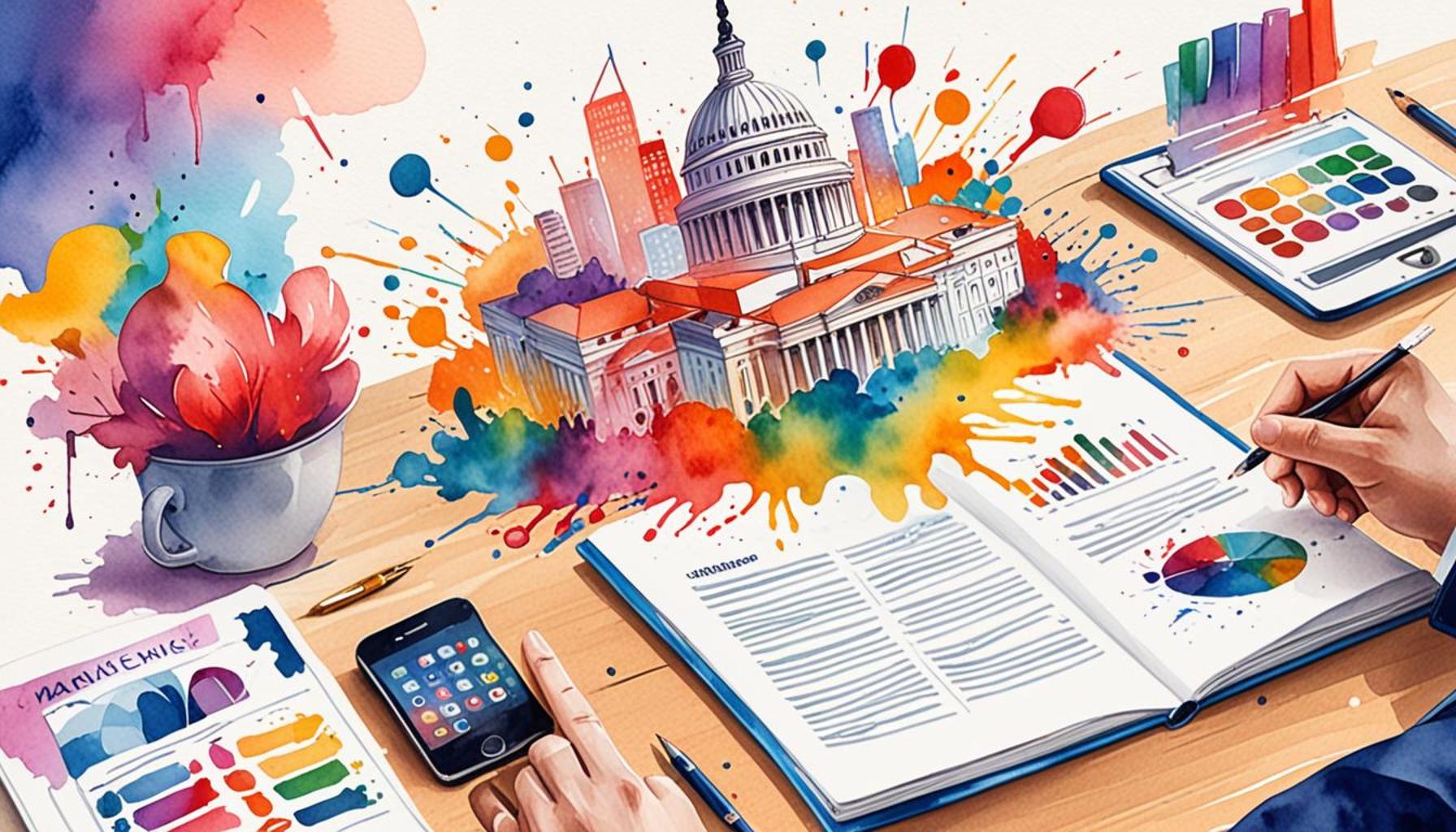Digital Marketing Strategies to Increase Participation in Government Programs

Unlocking Engagement through Digital Marketing
In an era where digital presence defines success, governmental agencies are increasingly seeking innovative ways to enhance public participation in essential programs. Leveraging digital marketing strategies not only provides access to vital information but also fosters community engagement among diverse populations. With over 90% of Americans using the internet, the potential for reaching and engaging audiences is enormous, enabling agencies to connect effectively with the communities they serve.
To maximize participation, agencies can employ a variety of targeted approaches tailored to meet the needs of different demographic segments. For instance:
- Social Media Campaigns: Engaging visuals and interactive content are powerful tools for attracting a broad demographic. Platforms such as Facebook, Twitter, and Instagram allow agencies to disseminate information quickly and encourage dialogue. For example, a city government might post infographics about local health services, paired with community testimonials, to humanize their initiatives and encourage sharing.
- Email Marketing: Personalized communications, such as newsletters or alerts, keep citizens informed about upcoming initiatives. By segmenting their audience based on interests or previous engagement, agencies can ensure that the information is both relevant and timely. A local housing agency might send customized emails highlighting new housing options suited for specific neighborhoods.
- SEO Optimization: Ensuring that government programs are easily searchable on the web boosts visibility and accessibility. By incorporating relevant keywords into their website content and implementing a user-friendly design, agencies can enhance their online presence. For example, using phrases like “affordable housing assistance” can help the right audience discover services more readily.
- Community Partnerships: Collaborating with local organizations enhances outreach and credibility. By forming alliances with trusted community groups, government agencies can tap into existing networks for disseminating information. A partnership with a local non-profit focused on youth mentoring, for example, could facilitate awareness of educational programs among families.
Additionally, understanding the challenges faced by citizens in accessing government services is critical. Many individuals cite issues such as complex application processes and lack of awareness as significant barriers to participation. Streamlining these processes through user-friendly digital solutions can significantly mitigate these obstacles, creating a more inclusive environment where every citizen feels empowered to engage.
Government programs have a substantial impact on community welfare, and increasing participation is essential to their success. This article delves into effective digital marketing strategies designed to engage and inform the public actively, ensuring that vital services reach those who need them most. By embracing these modern techniques, agencies can transform public engagement from a challenge into an opportunity, fostering a culture of participation that strengthens the fabric of our communities.
RECOMMENDED: Check out this similar article
Engaging the Public through Targeted Approaches
To effectively increase participation in government programs, it is crucial to harness the power of digital marketing in a strategic manner. Each demographic segment has unique characteristics and preferences that must be considered when formulating outreach efforts. Below are several key strategies that have proven successful in engaging the public and ultimately driving higher enrollment in various government initiatives:
- Content Marketing: Creating informative and engaging content plays a vital role in captivating potential participants. Blogs, videos, and podcasts can be utilized to discuss government programs, share success stories, and explain benefits in an easily digestible format. For example, a local health department could produce a series of videos featuring community members who have successfully utilized health services, showcasing real-life impacts.
- Influencer Partnerships: Collaborating with local influencers can amplify the reach of government initiatives. Influencers who have established trust and connection within the community can promote programs through their platforms, driving awareness and engagement. This strategy allows agencies to tap into pre-existing relationships and extend their outreach to hard-to-reach groups, including younger demographics.
- Webinars and Virtual Town Halls: Hosting online events provides an opportunity for direct interaction with the public. Agencies can explain programs, answer questions, and gather feedback in real-time. Incorporating a Q&A section allows for transparency and educates citizens on how to access services. For example, a state agency could hold webinars focusing on the application process for small business grants, removing barriers to entry in the process.
- Mobile-First Approach: With the majority of the population accessing content via smartphones, it is imperative for government websites and applications to be mobile-friendly. A responsive design ensures that information is accessible anytime and anywhere. Simplifying access through SMS alerts for deadlines and updates can also keep citizens informed and engaged with crucial services.
Understanding the barriers that citizens face is equally important to designing effective outreach strategies. Many individuals experience information overload or encounter technical difficulties when navigating government websites. Therefore, simplifying application processes and providing clear instructions can alleviate stress and encourage participation.
Finally, utilizing data analytics can provide insight into community needs and preferences. By studying engagement metrics—such as click-through rates and social media interactions—agencies can fine-tune their messaging and methods to align more closely with the interests of the public. This tailored approach not only maximizes reach but also ensures that government programs resonate with a diverse audience, leading to increased participation.
| Advantages | Details |
|---|---|
| Enhanced Reach | Utilizing social media platforms increases the visibility of government programs, reaching diverse audiences that traditional marketing methods might miss. |
| Targeted Campaigns | Digital marketing allows for segmentation and personalization, enabling campaigns to be tailored to specific demographics for more effective outreach. |
| Cost Efficiency | Digital marketing strategies can be less expensive than traditional media, freeing up budget resources for more extensive outreach efforts. |
| Real-Time Analytics | Immediate access to performance data allows for adjustments and optimizations during campaigns, enhancing overall effectiveness. |
| Increased Engagement | Interactive marketing techniques foster a two-way communication channel, encouraging public participation and feedback. |
Digital marketing strategies not only modernize the outreach of government programs but also create avenues to engage citizens more effectively. One of the key advantages is the potential for enhanced reach. By harnessing platforms like Facebook, Twitter, and Instagram, government entities can connect with younger and more technologically-savvy demographics, ensuring that all segments of society are informed about available resources. Moreover, the capability for targeted campaigns enables governments to craft messages that resonate with specific groups, like families, seniors, or the unemployed, maximizing the impact of each campaign.Another significant benefit lies in cost efficiency; digital strategies typically require less financial investment than traditional media outlets such as newspapers or television. This is particularly crucial when budgets are tight. In addition, real-time data analytics allow organizations to adapt their marketing strategies promptly, ensuring they remain relevant and effective in reaching their goals. Ultimately, these strategies not only provide tools for better communication but also encourage a culture of participation among constituents, leading to heightened trust and involvement in government initiatives.
YOU MAY ALSO LIKE: Read read another article
Leveraging Social Media for Increased Outreach
In today’s digital age, social media platforms serve as essential tools for government agencies aiming to engage with the public effectively. With billions of active users, platforms like Facebook, Twitter, Instagram, and TikTok enable governmental bodies to reach diverse demographics quickly and efficiently. Implementing a robust social media strategy can dramatically improve participation in government programs. Here are some compelling tactics to consider:
- Targeted Advertising: Utilizing targeted ads ensures that messages reach specific groups who may benefit from government programs. For instance, Facebook Ads can be customized to show relevant content to users based on their interests, location, and even their recent online activity. A city government might create ads promoting a local job training program targeted at unemployed individuals within the area, maximizing efficiency in outreach efforts.
- User-Generated Content: Encouraging citizens to share their experiences with government services provides authentic testimonials that can inspire others to participate. Agencies can launch hashtag campaigns that invite users to showcase how they’ve benefitted from programs. This organic engagement not only boosts awareness but fosters a sense of community and belonging, crucial for driving participation.
- Live Streaming: Hosting live Q&A sessions on platforms like Facebook Live or Instagram Live allows for real-time interaction and can humanize government agencies. An agency can invite experts to discuss complicated topics, such as health initiatives or tax assistance programs, while answering questions from viewers. This approach demystifies government services and establishes a more approachable image.
- Visual Storytelling: In a fast-paced digital environment, visuals often capture attention quicker than text. Government agencies can create infographics, videos, and shareable content that succinctly explain program benefits and processes. For example, an infographic detailing the steps to access food assistance could be shared across social media channels and community boards, making it easier for those in need to take action.
Enhancing Digital Accessibility and Inclusion
Digital marketing strategies must also prioritize accessibility and inclusion to ensure that all community members can participate. Barriers such as language differences, disabilities, and limited technological proficiency can hinder engagement in government programs. Therefore, implementing inclusive strategies is critical:
- Multilingual Content: Providing information in multiple languages not only showcases inclusivity but also significantly broadens outreach efforts. Agencies should assess the predominant languages in their communities and develop multilingual content for critical programs. For instance, Spanish-speaking residents may greatly benefit from translated materials related to health services and pandemic assistance programs.
- Accessible Websites: Websites and application platforms must be designed to accommodate users with disabilities. Utilizing accessibility guidelines—such as the Web Content Accessibility Guidelines (WCAG)—can ensure that all individuals, regardless of their abilities, can access vital information comfortably. This can include text-to-speech features, alt text for images, and easy navigation options.
- Digital Literacy Campaigns: Many citizens may feel overwhelmed by technology, which can limit their participation in government programs. Launching workshops and training sessions aimed at enhancing digital literacy could educate residents on utilizing online services, making participation less daunting. These efforts might include straightforward tutorials on completing online forms or navigating program details.
As government agencies explore these digital marketing strategies, they must continuously assess their effectiveness and adapt to changing community needs. This proactive approach will ultimately foster a culture of engagement, ensuring that government programs are an accessible and beneficial resource for all citizens.
CHECK OUT: Click here to explore more
Conclusion: Empowering Communities through Digital Marketing
As digital communication rapidly evolves, government agencies must leverage innovative digital marketing strategies to effectively engage with their communities and enhance participation in essential programs. By harnessing the power of social media, creating visually appealing content, and ensuring accessibility for all citizens, these agencies can break down barriers that often prevent individuals from accessing vital services.
The strategies discussed—ranging from tailored advertisements to inclusive content delivery—highlight the importance of addressing diverse community needs. In particular, initiatives such as multilingual communications and digital literacy workshops serve as vital components in cultivating an informed citizenry capable of navigating government services confidently. Government agencies not only enhance their reach by implementing these strategies but also foster a sense of trust and belonging among constituents.
Furthermore, it is crucial for these agencies to invest in ongoing assessment of their digital outreach efforts, adapting them based on community feedback and changing demographics. By adopting a data-driven approach, government programs can remain relevant and accessible, ensuring that they truly serve the populations they aim to assist. Therefore, as we move forward into a more interconnected world, the potential to increase participation in government programs lies heavily in the hands of strategic digital marketing practices that prioritize engagement, accessibility, and inclusivity. Embracing these principles may ultimately empower every citizen to benefit from government initiatives that enrich their lives.


